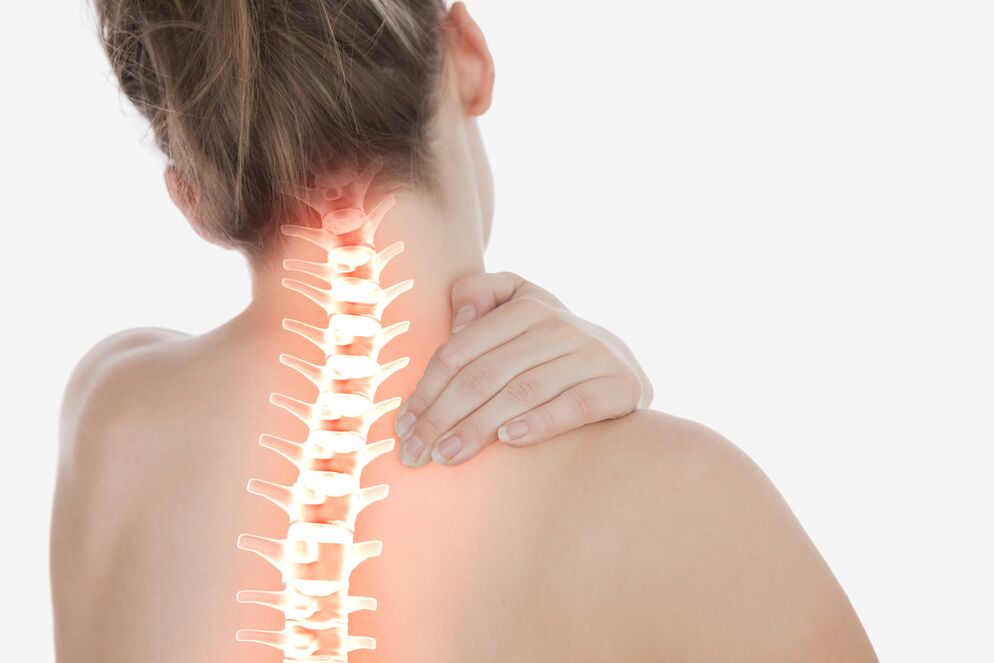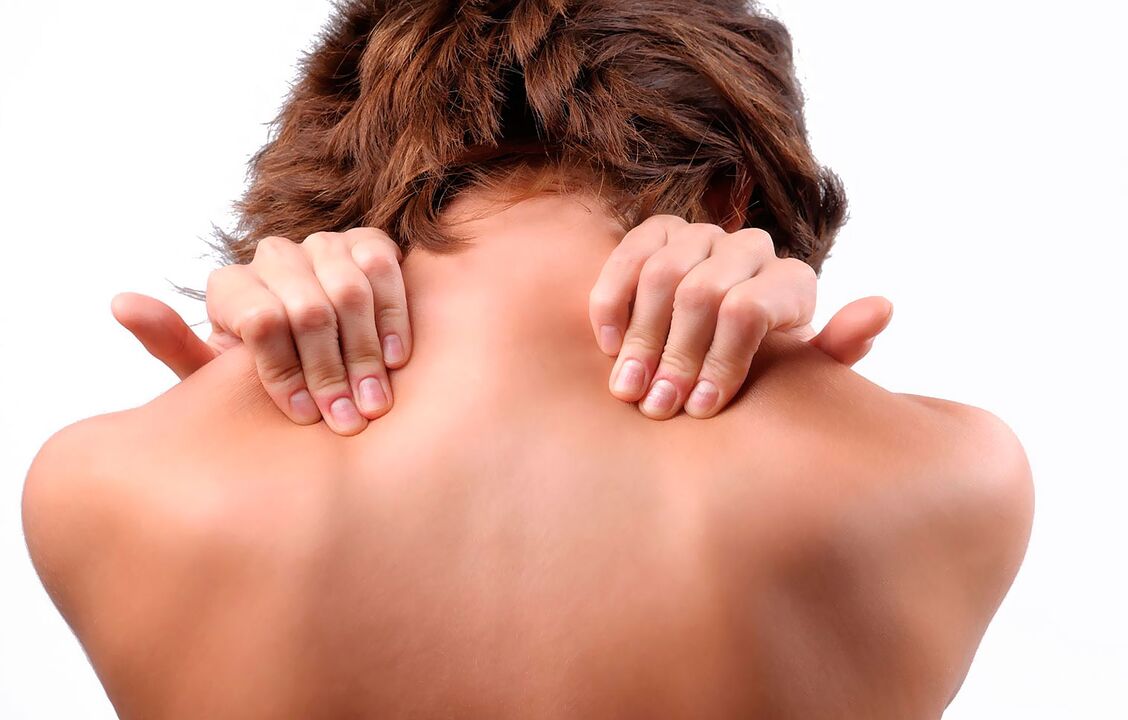Osteochondrosis of the spine is a disease caused by destroying tissues of bones and cartilage of uterus, thoracic and lumbar spine.
First of all, with the advancement of the disease, the central part of the spinal disc is changed - so - a flushed jet core. Therefore, the vertebra loses some of its properties in the absorption of shock, and training and cracks on the fibrous ring along the disk peripheral.

Further progression of osteochondrose Spine leads to disease complications - Protection of discs or ruptures of fibrous rings and intervertebral hernia, as a consequence. Spine instability in the affected area leads to pain and limited head mobility in osteochondrose to the neck, as well as limited body mobility with osteochondrosis of thoracic spine and lumbar.
In 75% of cases, the osteochondrose of the spine is the cause of the back pain. With age, the risk of spinal tissue dystrophy is significantly increasing, so the symptoms of osteochondrone was observed in each other resident of the planet for 30 years.
Causes of osteochondrose spine
Provocative factors in the development of osteochondrose spine are considered to be injuries or systematic load on their backs with hard physical work or professional employment in vibration conditions. If you have to make a lot of loading and unloading, buy a hydraulic collection for your car.
Early manifestation of the symptom of osteochondrose spine is caused by poor physical development, straight legs or excess weight. There is also a genetic predisposition for the loose structure of intervertebral disks and abnormality of the structure of the spine. Intensive training in the gym breaks rules for distribution of cargo on the back, sitting lifestyle and irregular diet are unfavorable and in terms of the health of the spine.
Symptoms of spine osteochondrosis
The disease is manifested as a number of typical symptoms. Osteochondrosis of spine is characteristic: painful back pain, a feeling of stiffness in the affected spine, reducing the amplitude of movement, increases weight raising, sharp movement, tension during coughing or sneezing.
Chronic pain, as one of the symptoms of osteochondrose spine, causes increased fatigue. When compressing the nerves of the spine, the pain can be more intense and sharp. Its localization in this case is not limited to the area of the back, but feels a person in the area of limbs.
Stages of osteochondrose Spine
The stage of the disease depends on the weight of the symptom of osteochondrose spine. In the first phase of osteochondrose spine, the pain is practically not feeling, if only a light little rise and poor stability of the spine for injuries. Destruction of the fibrous ring, reducing the size of vertebrate and the pain of various intensity symptoms is osteochondrose of another stage of spine.
The third phase of the disease is characterized by significant deformations of bones and vertebrae and vertebrae tissue until the occurrence of intervertebral hernias. Symptom osteochondrose Spine The oldest Fourth phase is mass growth of bones, limited mobility, intense pain, as well as complete or partial paralysis of limbs caused by compression of nervous roots.
Symptoms of osteochondrose cervix
Osteochondrosis of cervical spine often leads to blood circulation disorder due to artery compression. This leads to an intense headache, dizziness and unconsciousness. With osteochondrose of cervix, the uder syndrome is sometimes observed. It is characterized by a feeling of noise in the head, a picture of "flies" or colored stains in front of the eyes. With osteochondrose of cervix, the peripheral pain in the shoulders or arms are possible.
Symptoms of osteochondrose thoracic spine
Osteochondrosis of thoracic spine can worsen the course of various heart pathologies. The disease causes advancement in neuralgia to increase annoyances). With osteochondrose of the thoracic spine, the pain in the chest and sensation "of the" share "in the middle of the chest.
Symptoms of osteochondrose lumbar spine

Osteochondrosis of the lumbar spine leads to the development of the following diseases: Lumbago and Hernia.
Ishias, as one of the complications of osteochondrose of the lumbar spine, is characterized by damage to nerve irritation, pain in the gluteal region, hypotension (reduced tone) of veal and glutel muscle muscles.
With lumbago symptom of osteochondrose lumbar spine, there is sharp pain in the lower back, caused by moving the vertebral or loss of the spinal disk.
Lumbar radiculite, another complication of osteochondrose of the lumbar spine, provokes the Kiel the lowest spine discs. Follow in pain in buttocks with irradiation in the back of the thigh, hole below the knees, lower legs and feet.
Diagnosis of osteochondrose spine
A preliminary diagnosis of "osteochondrose spine" establish a neurologist after initial examination regarding the patient's back pain in back and limited mobility. Stage of osteochondrose spine is determined depending on the degree of spine deformation, patient's position and number of affected disks.
All the above symptoms of osteochondrose spine is diagnosed with feeling patient's back. The doctor also pays attention to the state of the muscle tone. Since in most cases, the disease is accompanied by the hyperbeanness of the rear muscle.
Use of spine bending tests, the patient's movement amplitude is determined. Thanks to the use of radiographs, CT and MRI, the diagnosis is stated and the future tactic treatment of osteochondrose spine.
Treatment of osteochondrose spine
In treatment of osteochondrose, spinal, conservative and surgical methods were used. The goal of both is eliminating pain syndrome and prevent further progress of spinal deformation.
At the same time, the surgical treatment of spinal osteochondrose is used only if the conservative therapy of the disease is inefficient.
The active phase of the application of conservative methods lasts an average of 2 months. At the beginning, a short term increase in pain syndrome caused by body reaction to drugs, exercise physiotherapy (exercise therapy) and physiotherapy. In a conservative treatment of osteochondrose spine, massage, hand therapy, extract and reflexology are also used. The efficiency of osteochondrose treatment of the spine depends on the systematic nature of the patient's procedures and persistences in executing exercise complexes.
The surgical treatment of spinal osteochondrosis is performed by a hernia of intervertebral discs, whose long exceeds 6 months. The operation for operation is also reducing the gap between the vertebral to 1/3 of the initial size and compression of the root of the spinal cord.
The leading method in the surgical treatment of the spine osteochondrosis is discoctomy, ie. Removing the deformed disk. The operation can be minimally invasive using endoscopic tools using the method of microdoseectomy, B-TWIN system, as well as laser evaporation of the deformed disk.
After surgical treatment of osteochondrose spine, the rehabilitation period is expected in 6 months. During this, the patient is focused on the treatment of Sanatorium-Resort to undergo the body of physiotherapy, manual therapy, acupuncture, etc.



















